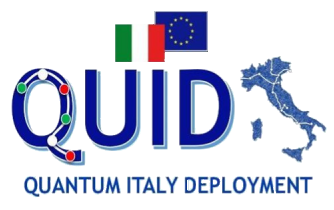The project QUID (Quantum Italy Deployment) proposes to start the deployment of the Quantum Communication Infrastructure (QCI) in Italy. QUID deploy systems and networks on the national territory to test quantum communication technologies, and in particular for the quantum distribution of cryptographic keys, with attention to integrating them with existing telecommunications fiber optics networks.
On the other hand, QUID foster the uptake of QKD systems and networks from use cases. The project is based on the deployment of several Nodes in Metropolitan Area Networks based on Discrete Variable QKD, connected by a fibre backbone.
During the project, several nodes will test QKD systems, while long-distance deployment will use techniques based on Trusted Node, or Twin Field QKD (Untrusted Nodes). QUID will connect also sites relevant for interconnection with the space segment of the European QCI. Last, since QKD still offers relevant possibilities of innovation, QUID devotes activities towards improving QKD features, in particular high-rate, use of innovative fibres, and the use of free-space QKD, to be implemented for mobility and where fibre is not present.
To deploy a proper ecosystem, QUID consortium is composed of leader Italian companies in the field, integrating systems, manufacturing QKD devices, operating telecommunication networks, and offering cyber security integrated solutions. As well, the main research institutes involved in quantum communication in terrestrial and space segment are present, as well as five among the more relevant universities, committed to innovation and training.
- The project QUID is going to
deploy QKD systems and Networks in the main 7 Italian towns (Turin, Milan, Padua, Trieste, Florence, Rome, Naples), referred to as Quantum Metropolitan Areas (QMANs). - connect the Q-MANs by fibres to the Italian Quantum Backbone (IQB), a fibre backbone infrastructure running from North to South Italy.
- deploy two long-haul geographical connections (Bologna-Trieste, Fucino – L’Aquila – Rome)
- lay down the initial infrastructure to connect National QCI in France, Austria, Slovenia and Croatia.
In QUID it is expected that:
- Italian technology will be deployed. To obtain this goal, QUID involves as partner the 3 Italian companies producing QKD devices (Cohaerentia, QTI, and ThinkQuantum), supported by academia (University of Padua, Polytechnic University of Milan, National Research Council). To properly integrate quantum and classical technology, QUID involves industrial partners at the core of Italian industrial system for telecommunications (TIM, TOP-IX), system integration (Telespazio, TAS-I, Leonardo), security technologies (Telsy, Leonardo)
- systems and networks will be widely available for undertaking and testing in a number of real use cases, also by linking public authorities within the country. QUID offers 8 use cases to test high security QKD provisioning. Moreover, QUID involves the Italian Metrological Institute (INRIM) to ensure the alignment of testing protocols and campaigns with the best practice addressed by certification and standardisations bodies, both for components and devices. QUID will make quantum networks available to industries operating the network’s different layers, from the QKD device to the integration, to the network management, to the customer care: a complete supply chain in Italy.
- long-distance quantum communication will be demonstrated. QUID targets 2 long distance quantum communication networks, using Trusted Nodes and Untrusted Nodes architectures. QUID involves INRIM, CNR, Leonardo, TAS-I, TIM, that already participate to the definition of the overall EuroQCI system architectures in EC projects like OQTAVO and QSAFE.
- Systems and technologies will operate in traditional telecommunications networks to prepare the large-scale uptake and use. QUID involves on purpose TIM and TOPIX, the largest telecommunication operator and Internet Exchange in Italy respectively. They offer their expertise in managing real traditional telecommunications networks, considered also their role in national critical infrastructures. QUID will make these quantum networks available to industries operating the network’s different layers.
- quantum and traditional cybersecurity systems in communication systems and networks will be integrated. QUID involves Telsy and Leonardo, leader in this field in Italy, with dedicated activities to traditional cybersecurity integration with quantum devices and post-quantum solutions.
- interface between the QCI’s space and terrestrial systems will be tested. QUID dedicates an activity to this aspect, involving the main Italian partner for space activities, i.e. the National Space Agency ASI, and its premises in Matera, the Space Center “Giuseppe Colombo”, with its telescope. This is the most relevant Italian site to connect terrestrial and space EuroQCI in Italy. Moreover, QUID connects the site in Matera to the rest of the country using the IQB fibre backbone infrastructure.
- technical and research staff as well as national users will be trained. QUID directly involves 5 among the most relevant Italian universities involved in Quantum Communication: University of Rome La Sapienza, Padua, Trieste, L’Aquila, and Naples.
QUID dedicates a specific activity to training of different type of stakeholders: involved technicians, users, and next generation engineers for national QCI.
